Common reasons for pothos yellow leaves are overwatering and root rot or underwatering. Also, the yellowing may occur from too much or too little light, extreme temperatures, overfeeding, or nutritional deficiencies.
Sometimes, pothos leaves turning yellow may be due to pests, diseases, low humidity, or being rootbound. Thus, it would help if you looked at other signs to know possible causes.
We will give you information on each of these causes, give you signs, and how to fix the issues. It may occur with curling leaves, brown spots, tips or margins, wilting or drooping, and so on.
What we are going to see applies to the various varieties or cultivars. They are the exact reason for your jade, pearls and jade, marble queen, neon or golden pothos yellow leaves. But this doesn’t include silver or satin pothos, whose scientific name is Scindapsus pictus, not Epipremnum aureum like the rest. Their growth needs are different.
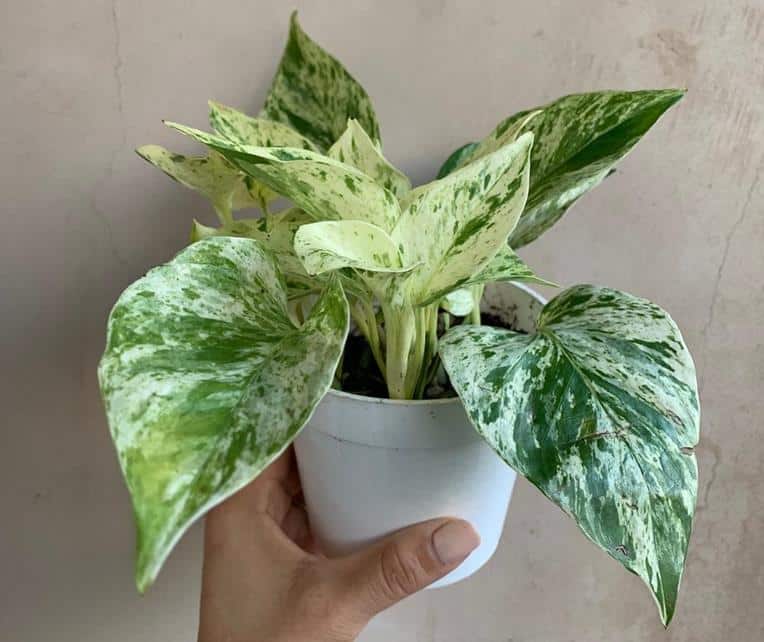
Contents
- Pothos care and growth requirements
- Reasons and signs for pothos yellow leaves
- 1. Improper watering may cause pothos yellow leaves
- a. Underwatering
- b. Overwatering and root rot
- 2. Light and pothos plant yellow leaves
- a. Too little light
- b. Too much light
- 3. Extreme temperature
- a. Heat stress
- b. Cold drafts and chilly conditions
- 4. Nutritional deficiencies and overfeeding
- a. Nutritional deficiencies
- b. Too much fertilizer
- 5. Pests
- 7. Diseases
- 8. Low humidity
- 9. Being rootbound
- Normal reasons for pothos yellow leaves
- 1. Aging
- 2. Plant shock
- Frequently asked question FAQs
Pothos care and growth requirements
Before we see the reasons for your pothos leaves turning yellow, we give care and growing needs. Why? The answer is simple. From our experience, failure to provide ideal growth and care needs is the most common reason for the yellowing, browning, spots, curling, drooping, slow growth, etc.
| Care level | Low or easy |
| USDA hardiness zone | 10 to 12 |
| Temperature | 65 to 85°F. But they don’t mind up to 90°F or as low as 55°F |
| Humidity | They prefer high humidity but will still do well at 50% or more. |
| Light requirement | Bright, indirect light can thrive in lower light |
| Best soil | Slightly acidic (pH 6.1 to 6.5), a well-drained and nutrient-rich potting mix. |
| Watering | Moderate. Allow the top 1-2 inches of the soil to dry before another watering session |
| Fertilizer | Pothos are medium feeders. Use a balanced houseplant fertilizer once in 4-6 weeks during growing seasons only. |
| Pruning and grooming | Use sterilized gardening shears to cut dead, diseased, or damaged leaves. You can chop a few branches to control shape, growth and make your plant fuller in spring and summer. |
| Repotting | Repotting is after about two years, or if rootbound |
| Propagation | Stem cutting |
| Toxicity | Toxic, poisonous, or harmful to humans, dogs, cats, and other pets |
Reasons and signs for pothos yellow leaves
Pothos leaves turning yellow signify that these plants cannot make enough chlorophyll, a condition known as chlorosis or something is degrading it. Thus, anything that damages cells, especially chloroplasts (holds chlorophyll cells) or denatures protein complex where this pigment is bound, are possible causes.
You also need to know that these plants need some minerals and light to make chlorophyll. Also, water is essential (helps to absorb and transports minerals), and optimum temperature will favor the process.
1. Improper watering may cause pothos yellow leaves
Overwatering and underwatering are two common reasons for pothos yellow leaves. How do they cause this issue?
a. Underwatering
Dry soil or underwatering will make your plant unable to absorb nutrients or water. Thus, the leaves may turn yellow.
First, your leaves will start to droop or wilt and, your plant will look limp but will improve with watering. Also, your pothos leaves will curl upward, feel dry, turn yellow, and have crispy margins and tips. Other signs are stunted growth, leaves dropping.
Fix
Feel the first few inches with your finger or up to the first knuckle of your finger. If dry, you need to give your plant a good drink immediately. Alternatively, you can use XLUX Soil Moisture Meter and water when the reading is in the dry (red) zone.
You can use any watering method. See more on how often to water pothos. It has all the details, including top, bottom, and self-watering.
The be watering our pothos when the top 1-2 inches of the soil feels dry. Don’t follow a watering schedule. Why? Because water needs depend on season, environmental conditions, plant size, pot size, or type.
That is not all. You need to keep optimum humidity, temperature and have a potting mix that holds moisture without being so dry. If you have a small pot, consider getting a slightly larger one.
Lastly, if you forget watering, get approximately the number of days your plant takes to the next watering session. Set a reminder. But before watering, feel the soil.
b. Overwatering and root rot
Constantly soggy soil and yellow lower leaves may indicate pothos overwatering. If not fixed, root rot will set in and eventually kill your plant.
Soggy soil chokes oxygen from roots making them not able to absorb water or minerals. Also, the condition favors the growth of some bacteria and fungi. These microorganisms will then attack the roots, causing root rot.
More telltale signs are a wilting or drooping plant that won’t improve with watering and brown or black splotches on leaves. Also, the leaves will feel soft and not dry, as in the case of underwatering.
Last but not least, you may see white, tan, or brown warty-like growth due to leaf edema, a mushy stem, slow growth, among other signs.
Fix
Hold on to the watering and investigate the cause. It may be poorly drained soil, heavy soils, oversized pot, low light, temperature, or high humidity. Also, blocked drainage holes can cause it. Fix any, including changing to switching to a well-draining potting mix like Miracle-Gro Indoor Potting Mix.
If your plant has no root rot (brown or black roots), poke the soil with a pencil to improve air circulation and faster drying. Then, maintain optimum growing conditions and ensure good air circulation.
In case of root rot, you need to repot your plant. Cut any brown or black roots with sterilized gardening shears. Also, get rid of any soil on the roots and discard it.
Sprinkle it with a fungicide like Garden Safe Brand Fungicide3 and repot it to a new pot. If caught early, your plant may survive.
2. Light and pothos plant yellow leaves
Does your plant get too much or too little light? These two are possible reasons for your pothos leaves turning yellow. How?
a. Too little light
Too little light is a widespread cause of pothos plant yellow leaves. Like other flowering plants, they need light to make chlorophyll. If they don’t get enough light, leaves look pale, whitish, or yellow, especially emerging ones.
Other signs are smaller leaves, a leggy plant with sparse growth that may grow towards the light, and slow or stunted growth. Also, it will take longer for the soil to dry, leaves may drop, and any variegated pothos will lack proper coloration.
Fix
Grow your pothos in bright, indirect light (with 10,000 to 20,000 lux). If your apartment doesn’t receive enough, go for artificial grow lights.
For your pothos plants, you can go for GE Grow Light LED Flood Light Bulb (American-made). It will last for up to 25,000 hours. Other good brands are Barrina, VIPARSPECTRA and Relassy.
If you don't know if the brand you are using gives enough light, invest in an illuminance meter. Dr. meter LX1330B Digital Illuminance Light Meter is such a good brand.
b. Too much light
Paradoxically, too much or direct sunlight will degrade chlorophyll. Thus, you may notice faded, washed out, or bleach leaves that may be yellowish or have yellow patches on leaves close to the light source.
That is not all. Your pothos will have dry and brittle brown leaf tips or edges that may turn up. Also, since more light means faster water loss, leaves may curl or droop or wilt but won’t fall easily.
Fix
Avoid exposing your plant to direct sunlight. Put your pothos at a distance from the window, where no direct sun reaches, especially if you have a south-facing window. Outdoors, please put them in the shade, use a shade cloth or have a greenhouse.
3. Extreme temperature
Temperature influences plant physiological functions. So, extreme temperatures may be responsible for your pothos leaves turning yellow.
a. Heat stress
During hot summers, heatwaves, or when under high temperatures, those exceeding optimum range, pothos may have yellow foliage.
Why? Heat stress will affect various plant functions, including chlorophyll formation, and will increase water loss from leaves. Also, it may denature proteins that hold this green pigment. All these factors will cause leaf yellowing.
Signs include leaf burn (tips or margins turning brown or yellowish), leaf discoloration (yellowing and browning), curling, wilting and drooping. Also, leaves may fall off, your plant and your plant will grow slowly.
Fix
During hot days, take your plant to cooler places, including under a shade, or turn on your HVACs. Moreover, move your plant away from heat vents, fireplace, heat emitting appliances, or radiators.
That is not all. Don’t prune, fertilize, or transplant your plant at this time. It will only worsen things.
b. Cold drafts and chilly conditions
Winter cold draft and chilly conditions may inhibit various plant functions. Furthermore, the water in plants may freeze, damaging cells. So, some leaf discoloration may occur.
Signs to expect are leaf discoloration, i.e., turning whitish, yellow, black, or brown. This may include having pale brown patches in-between veins or whole leaves turning brown overnight. Also, your pothos leaves will wilt or droop and may look scorched.
Fix
In cold winter, remove your plants from cold or draft areas to warmer, less windy places. These places include on porch or patio doors, doorways, windows, or near air conditioning vent.
Next, you can use cold frames, and you should close windows at night or have blinds and curtains. Don’t fertilize your plants. Later, you can trim any dead leaves with a sterilized pruning scissor.
4. Nutritional deficiencies and overfeeding
If you don’t feed or overdo it, your pothos leaves may turn yellow. Too little causes a lack of some nutrients, while too much will affect the plant. Let us see how.
a. Nutritional deficiencies
Iron deficiency is the most notorious cause of pothos yellow leaves. But others like nitrogen, zinc, manganese, molybdenum, or sulfur may cause chlorosis. These mineral ions are either part of chlorophyll, participate in the formation, or act as enzyme activators. Thus, they will cause mainly interveinal chlorosis.
Iron is the most common reason, and it will make younger leaves the first to turn yellow, just as manganese. On the other hand, magnesium, nitrogen, and zinc will start with older inner leaves, moving outwards.
Molybdenum will similarly cause yellowing as nitrogen deficiency, while sulfur will also have necrotic tips in addition to chlorosis.
Fix
Feed your pothos with houseplant fertilizer once in 2 to 4 weeks when they are growing. When dormant (winter or fall), don’t apply fertilizers.
Choose a premium quality brand that is well-balanced. Why? Because too much zinc, calcium, phosphorus, copper, or manganese in the soil may affect iron availability.
Our favorite brand is Miracle-Gro Water Soluble All Purpose Plant Food. Why? Because it also has other micronutrients like manganese, zinc, copper, molybdenum, iron and boron.
Last but not least, make your potting mix has the correct soil pH (6.1 to 6.5) as it will influence the availability of iron, which is vital in chlorophyll formation. Also, ensure your potting mix is rich in organic matter. We add a little bit of Worm Castings Organic or compost to your potting mix.
b. Too much fertilizer
Too much fertilizer may deposit salts in the soil make it hard for plants to absorb water. Also, it may alter pH affecting the availability of some minerals or burn roots. All these affect water or nutrient absorptions, something that will cause foliage yellowing.
You may see fertilizer deposits on the potting mix, or your plants may suffer from fertilizer burns. Other signs are leaf drop and stunted growth.
Fix
Leach or flush the soil by pouring a lot of water through it. Also, you may change the potting mix.
5. Pests
Pest infestation may cause yellow spots on pothos leaves. Depending on the cause, you may see other symptoms like deformed, ruffled, or curling leaves.
Sap-sucking pests like aphids, thrips, mealybugs, scale insects, or spider mites will drink plant juices and damage cell tissues. This will cause yellow, brown, whitish, or black spots. Some will even inject toxins that make leaves curly, ruffled, or deformed.
Let us look at these common pests, give you signs, and what to do.
| Pests | Signs | Treatment or fix |
| Thrips | Appear as tiny, slender, yellowish to black insects with fringe wings. They will cause silvery stippling, leaf distortion, and drop. Also, leaves will have brown, black, or yellow spots | Hose the plant, use insecticidal soaps or dormant oil spray. |
| Mealybugs | Mealybugs are small, soft-bodied yellowish or pink insects with a grey or white powdery wax. Signs include honeydew, sooty mold, stunted growth, and leaf yellowing curling or falling. | Wipe leaves with a cotton ball dipped in rubbing alcohol or use neem oil, horticultural spray oils, or insecticidal soap |
| Spider mites | These are small, oval, yellow to pale white moving bugs that appear like dots. They will cause webbing, light spots or stippling, yellowing, leaf loss, or curling. | Use insecticidal soaps, horticultural oils, or miticides. |
| Scale insects | They appear as small raised bumps with a fluffy or waxy covering. Infestation signs include honeydew, leaf yellowing, and falling off prematurely. | Hose any visible insects and use horticultural spray oil or insecticidal soaps to manage them. |
We understand there are many brands of the above products and you may not know which one is good. Here is what has proven effective to us:
- Bonide BND022- Ready to Use Neem Oil
- Garden Safe Brand Insecticidal Soap Insect Killer
- Bonide (BND212) - All Seasons Horticultural and Dormant Spray Oil, Insecticide
7. Diseases
Pothos leaves turning yellow or having yellow spots may signify fungal or bacterial disease. These pathogens will feed on plant food, damage cells, and result in yellowing, browning, necrosis, and so on.
Luckily, diseases are not a common issue with pothos. Here are two common ones and how to manage them.
| Disease | Signs | Treatment |
| Bacterial leaf spot | Signs include water-soaked spots surrounded by a yellow halo. Later the site may fall, leaving a hole. | Remove any diseased leaves and use copper fungicides |
| Southern blight | They start as water-soaked spots or lesions. The infected plant will then turn yellow and wilt within a short time. In severe cases, it may collapse. | Treat with fungicides that have azoles like fludioxonil, PCNB, mancozeb, and so on |
8. Low humidity
Pothos love humid areas but can grow well in places with lower humidity. 50% or more is ok. But if it goes too low, it will cause faster water loss from leaves and potting mix. This may cause leaf burn (crispy brown tips or edges), brown spots, yellow leaves, and dull pothos.
More signs are leaves curling upward, stunted growth, and increased water needs.
Fix
It would help if you raised the humidity. Start by getting a hygrometer to help you measure relative humidity. It doesn’t cost much.
To raise the humidity, here is what to do:
- Mist your plant a few times a week
- Buy a humidifier. A brand like AquaOasis™ Cool Mist Humidifier runs for up to 24 hours and is perfect. It is quiet and has functions like auto-shut and a 360-degree rotating nozzle.
- Have a pebble tray
- Move plants to humid rooms like the kitchen or bathroom
- Group plants together. It helps create a microclimate.
9. Being rootbound
Roots growing from drainage holes and pothos leaves turning yellow is a sign your plant is rootbound. Leaves may also start curling, look scorched, droop or fall and your plant will be leggy and grow slowly.
Fix
If this happens during the growing season, you will repot your plant. Gently slide your plant out of the pot. Note that, at times, it may not readily come out.
Next, gently tap it to remove as much of the old soil as possible. Fill a new larger pot to about ⅓ level, plant your pothos and add more soil to the level it was before.
Last but not least, thoroughly water your plant.
Normal reasons for pothos yellow leaves
What we are calling usual reasons are those causes bound to happen. Thus, you shouldn’t worry much about them.
1. Aging
Aging or senescence will cause chlorophyll degradation. It will start with a few lower and older pothos leaves turning yellow, brown, and finally dying.
Just remove any dry or dead leaves. Why? They no longer benefit your plant but still depend on it. Also, they may attract pests.
2. Plant shock
Some pothos leaves yellowing may occur if you relocated your plant, received a new one, or transplanted it. Also, your plant leaves may droop or wilt, curl, look scorched, or even fall.
Also, your pothos leaves may be yellow after repotting them. This is part of plant shock.
Frequently asked question FAQs
If you see yellow leaves with brown spots, it is a likely indication of may be a sign of overwatering, root rot, pests, or diseases. Also, cold draft and low humidity may cause brown patches or splotches.
Yellow spots on pothos leaves are a sign of pest infestation. Also, it may be a sign of diseases, especially water-soaked or brown spots with a yellow hallo. Besides these two, too much light may cause yellow patches.

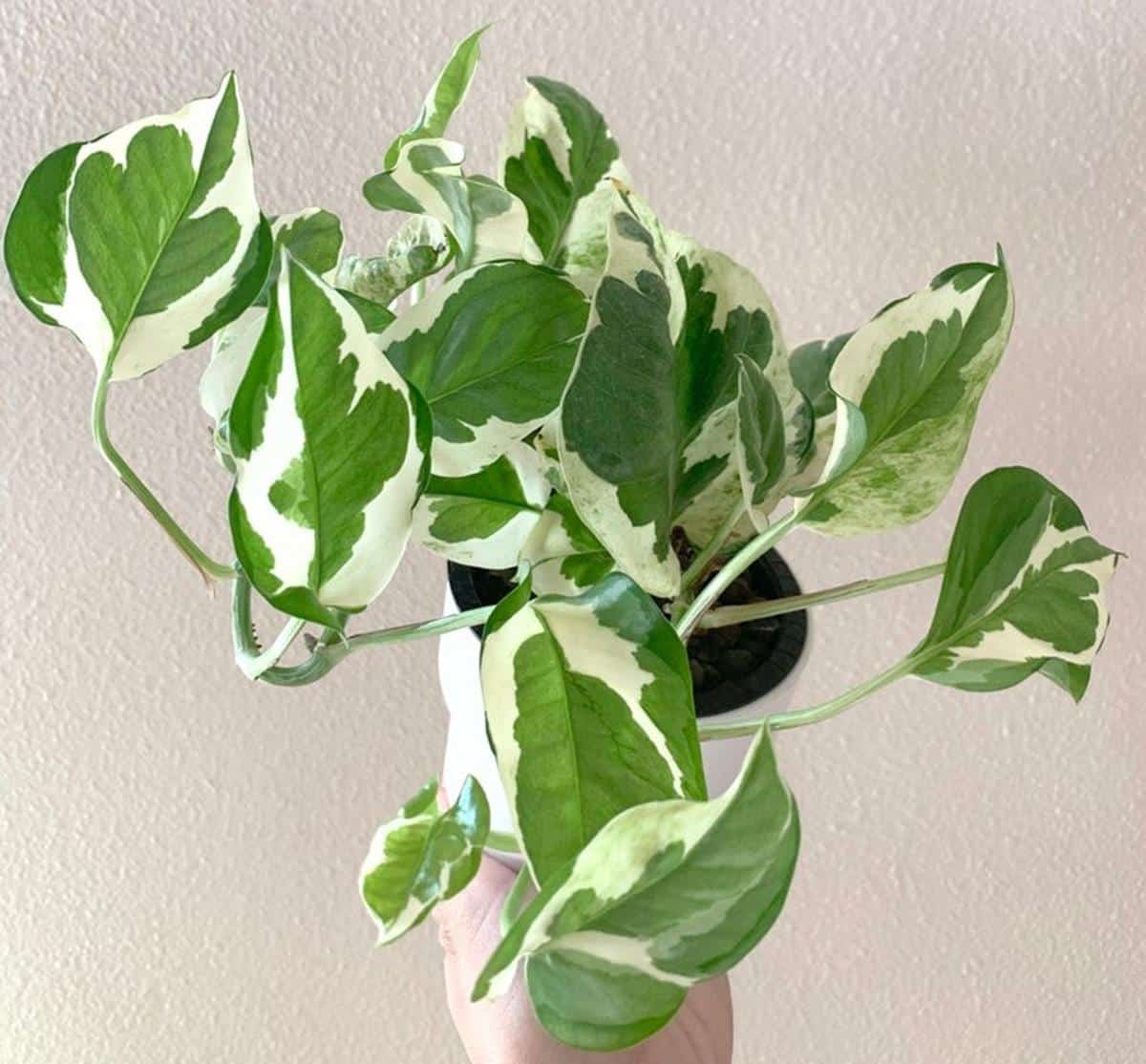
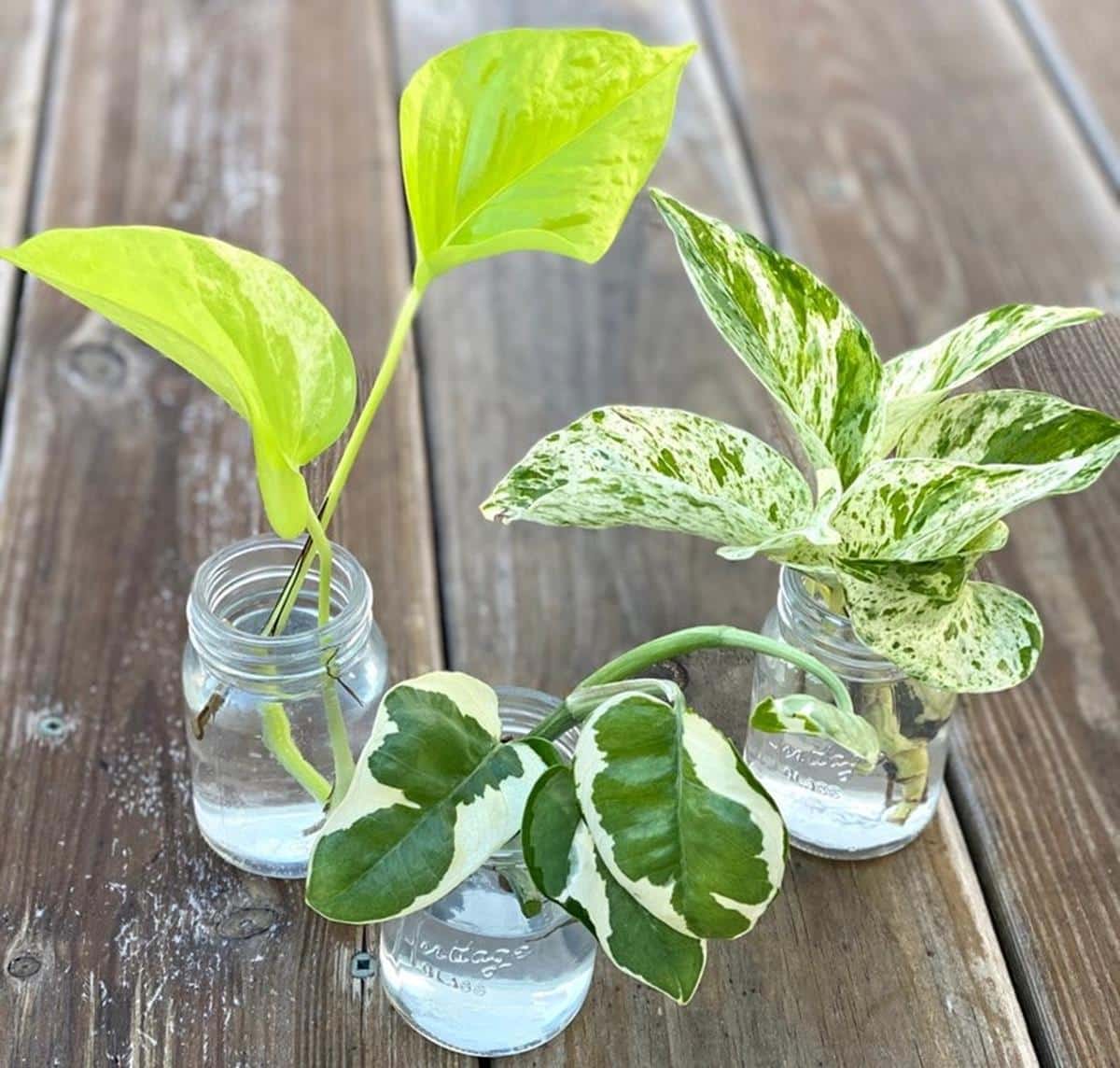
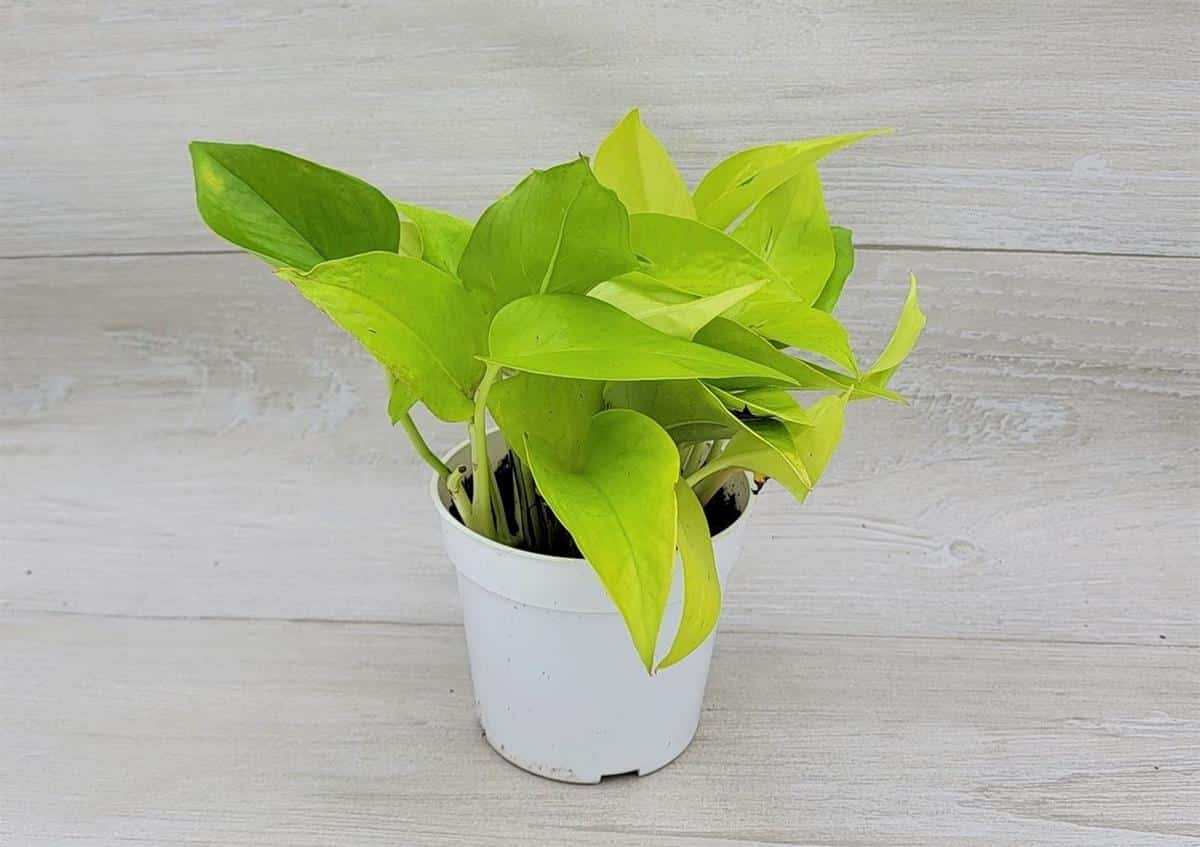
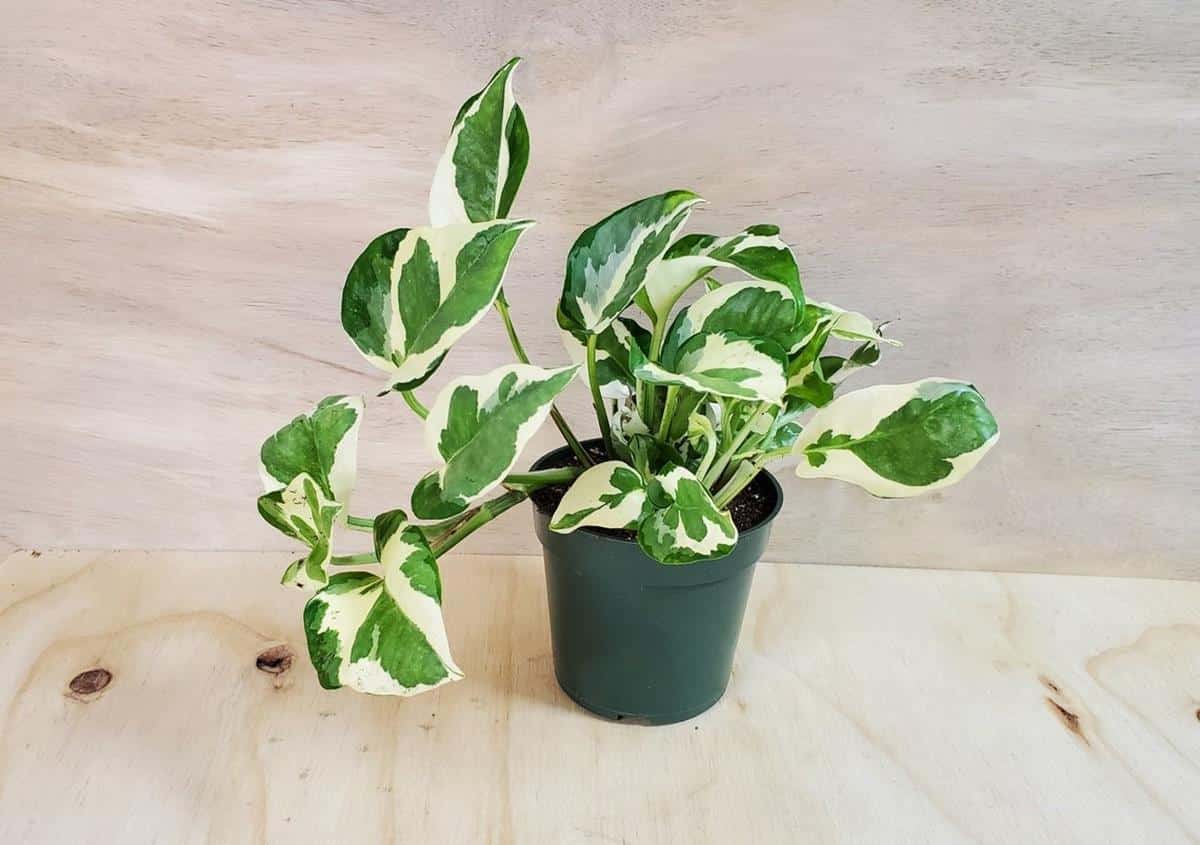
Leave a Reply